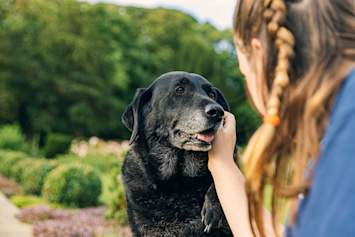
Just as we appreciate the depth of a fine wine or the complexity of an aged cheese, our senior pets offer us a rich companionship that only time can cultivate. At Embrace Pet Insurance, we understand that this deepening bond comes with a desire to provide the best possible care, regardless of age. That's why we're committed to offering pet insurance that grows and adapts with your furry friend. While it's true that premiums may change over time, we believe in the lasting value of protection.
So, we are here to shed light on why pet insurance premiums often rise as our furry friends get older, and how you can navigate these shifts while ensuring your pet remains protected.
Does Pet Insurance Go Up Every Year?
Pet insurance often increases every year, though not always. Understanding the reasons behind these increases can help you make informed and wise decisions about your pet's coverage. While Embrace covers all ages of pets, the premiums do go up a bit over time as our pets get older to account for the increasing risk of illness and injury. This practice is common in the pet insurance industry, reflecting the higher likelihood of health issues as pets age.
Factors Affecting Pet Insurance Premium Increases
Pet insurance rates are influenced by factors such as your pet's age, breed, location, and coverage selections. Other rating considerations may also apply, varying by state and policy. As pet care becomes more sophisticated and owners increasingly view pets as family members, insurance plays an even more crucial role in managing healthcare costs, so it's important to understand what affects your premium.
Age-related risks:
As pets age, they become more susceptible to various health conditions, increasing the likelihood of claims. As pets enter their senior years, they face an increased risk of developing chronic conditions. Common health problems in senior dogs include arthritis, diabetes, and heart disease, which can require more frequent veterinary care and treatment. These age-related health issues often require ongoing treatments or more complex procedures, resulting in higher veterinary costs. Additionally, older and senior pets may need extended recovery time and care after injuries or surgeries, leading to longer and more expensive treatment periods. The combination of the aforementioned factors means that as pets age, the probability of filing insurance claims rises significantly, which directly affects premium calculations.
Veterinary cost inflation:
Advanced medical technologies, like diagnostics and surgical procedures, offer more treatment options for pets, but they come at a higher price. Additionally, rising operational costs, including staff salaries and equipment expenses, contribute to higher veterinary fees. Insurance companies factor these trends into their pricing models, leading to potential premium increases across the board.
Overall pet health trends:
Insurance companies don't just look at individual pets; they analyze the health trends of their entire insured population. If they observe an increase in overall pet illness or injury rates, they might raise premiums for everyone. This is a preventative measure to ensure they have sufficient funds to cover the anticipated rise in future claims.
Inflation and economic factors:
Just like everything else, pet insurance isn't immune to inflation. As the general cost of living goes up, so do the costs associated with pet care. This includes everything from medications and supplies to veterinary staff salaries. This inflationary pressure forces insurance companies to raise premiums to maintain profitability in the face of these rising expenses.
According to the North American Pet Health Insurance Association (NAPHIA), the pet insurance sector has been experiencing significant growth, reflecting these changing attitudes and economic factors. Pet health care is getting more and more expensive, meaning that pet insurance is becoming a necessity for more and more pet parents to make sure they never have to decide if they can afford lifesaving care for their pets.
We at Embrace, are committed to providing consistent coverage for your pet throughout their life. While we need to adjust our prices as your pet ages due to higher health risks, we work hard to keep these increases fair and manageable. And we strive to keep our increases as reasonable as possible while maintaining comprehensive coverage.

How Much Does Pet Insurance Increase Each Year?
The amount can vary widely depending on factors such as your pet's breed, location, and overall health. While it’s good news that your pet insurance remains reliable even as your pet’s health begins to decline, the increase serves as a reminder that your pet is getting on in years and can have some pet parents reconsidering the cost-benefit of their coverage.
This was the case for Ditto, a 10-year-old Beagle originally from Cleveland, OH, and now living in Seattle, WA. Ditto was one of the first Embrace pets back in 2006, and we enjoyed getting photos and updates from this young lady. Fast forward to 2014, and Ditto's rates have increased, despite her being relatively healthy. Her most recent pet insurance premium increase was roughly 20%, an increase her pet parent felt was "steep," and he wrote in looking for advice on what to do with her coverage.
Managing Your Pet Insurance Costs as Your Pet Ages
Ditto's owner was unsure about keeping the current coverage but didn’t want to lose the protection it provided. Let's take a closer look at Ditto's dog insurance plan:
Ditto's Dog Insurance Plan
$500 annual deductible
90% reimbursement rate
$10,000 annual maximum
Optional rider: Wellness Rewards
Our crew was happy to help Ditto's family evaluate their protection for vet bills, discussing the following options to manage costs while maintaining coverage.
Adjusting coverage limits: Ditto's plan had a $10,000 annual maximum. We discussed whether this limit was still appropriate or if a lower limit might suffice, potentially reducing premiums. We asked Ditto’s family, “Now that your pet is older, would you still proceed with treatment for major medical issues, such as cancer? Would you go ahead with the chemo treatment or an invasive surgery?” If so, you'd probably want to keep the $10,000 coverage. If not, perhaps your annual maximum could drop to $5,000, which would cover accidents like broken bones, foreign body ingestion, and most illnesses, just not all of the big ones.
Changing reimbursement percentage: Ditto's 90% reimbursement rate provided excellent coverage. We explored how lowering this percentage could reduce premiums, while noting it would also decrease potential reimbursements. This comes down the knowing how much you could pay out of pocket if needed.
Increasing the deductible: Ditto's $500 annual deductible was moderate. We explained how raising this amount could lower premiums, though it would mean paying more for claims.
Reviewing optional coverage: We discussed whether the Wellness Rewards Plus rider was still providing value or if adjusting this optional coverage could help manage overall costs.
Is There Pet Insurance That Doesn't Increase with Age?
While some pet insurance companies may occasionally claim to not increase with a pet’s age, you’ll still find that those premiums increase over time. These policies may attribute these increases to other factors like rising veterinary costs or inflation, but they’ll still go up over time. At Embrace, we believe in transparent pricing that reflects the true cost of care as your pet ages, ensuring we can continue to provide robust coverage when your pet needs it most.
The Embrace Edge: Balancing Coverage and Cost
What sets Embrace apart in the competitive pet insurance landscape? It is our commitment to transparency, flexibility, and personalized care that is evident in every aspect of our policies. We understand that every pet and every family's needs are different, which is why we offer the following:
Customizable plans that allow you to balance coverage and cost effectively.
Coverage for curable pre-existing conditions after a 12-month waiting period
An optional, add-on wellness plan to help budget for routine care
Embracing Your Pet's Health Journey
Embrace understands that your pet is family, and their health is a top priority. While pet insurance premiums may increase with age, the value of having comprehensive coverage when your pet needs it most can far outweigh the cost.
Going back to Ditto’s story, his family ultimately decided to leave things as they are for now, considering their coverage a "good luck charm." Of course, no one knows if they might have a big vet expense as soon as they reduce or drop their coverage, but sometimes it feels better to not take a chance.
While premiums may increase over time, the peace of mind and financial protection provided by pet insurance can be invaluable. Regular policy reviews can help ensure you're getting the best coverage for your pet's current needs and your budget.
Have you ever reconsidered your pet insurance coverage? If you find yourself wondering "Why does pet insurance go up every year?" you may want to rethink your coverage. And when you want to compare pet insurance plans, our reps are just as good at helping you change the plan as they are at helping you get started, so it never hurts to call (855-977-2830) or e-mail us to re-evaluate your needs, even on a yearly basis.